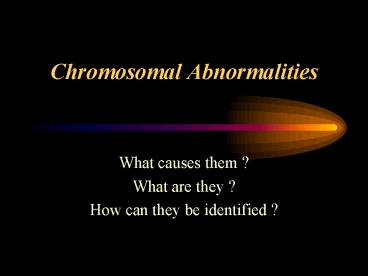Chromosomal Abnormalities - PowerPoint PPT Presentation
1 / 13
Title:
Chromosomal Abnormalities
Description:
Amniocentesis Chorionic villi sampling Alpha feto protein sampling Chordocentesis Amniocentesis ... The test identifies pregnancies at higher-than-average risk ... – PowerPoint PPT presentation
Number of Views:419
Avg rating:3.0/5.0
Title: Chromosomal Abnormalities
1
Chromosomal Abnormalities
- What causes them ?
- What are they ?
- How can they be identified ?
2
What can cause genetic abnormalities?
- Chromosomal abnormalities
- Single gene mutations
- Multifactoral diseases
3
Basic Types of Abnormalities
- Gene mutations - can be as simple as a one letter
change in the genetic code. These mutations
affect one gene only and may be in body or sex
cells. - Chromosomal mutations - these are changes that
alter the structure of a chromosome. This has an
effect on many genes. These may also be in body
or sex cells.
4
Types of Chromosomal Alterations
- The following mutations occur during crossover
of Prophase I. - deletion
- inversion
- translocation
- addition
5
Alterations of Chromosome Number
- Nondisjunction is a condition where chromosomes
fail to separate during Anaphase. This results in
a cell having one less chromosome or one too
many. - Monosomy
- Trisomy
- Animation of Nondisjunction
6
How can genetic abnormalities be identified?
- Amniocentesis
- Chorionic villi sampling
- Alpha feto protein sampling
- Chordocentesis
7
Amniocentesis
- Amniocentesis This is one of the best-known
prenatal diagnostic techniques for certain
congenital disorders. It is usually performed
between the 13th and 15th weeks of pregnancy. In
this procedure, a thin, hollow needle is inserted
into a womans uterus through the abdomen, guided
by ultrasound used to view the fetus. The
technician draws out some fluid surrounding the
fetus. Fetal cells floating in the fluid can be
analyzed to detect chromosomal abnormalities,
more than 100 metabolic disorders and some
anatomic defects. There is low risk (less than
one in 200) of miscarriage or infection following
the procedure. Results of the test are ready in
one to three weeks.
8
Chorionic Villi Sampling
- CVS is generally performed about the 10th or 11th
week of pregnancy. CVS is not routinely offered
to all pregnant women because the test carries a
risk of miscarriage, and possibly other
complications.. CVS requires taking a small piece
of the chorionic villi. Either a needle is
inserted through the abdomen or a slim tube is
inserted through the vagina to take a tiny tissue
sample from outside the sac where the baby
develops. The tissue is analyzed for chromosome
disorders or various genetic conditions. Results
are usually ready in one to two weeks.
9
Alpha-Fetoprotein Screening
- Alpha-Fetoprotein Screening This blood test is
most often done between 16 and 18 weeks. The
results are usually available within a week. The
test identifies pregnancies at higher-than-average
risk of certain serious birth defects, such as
spina bifida and Down syndrome. In most cases, an
abnormal test result does not indicate a problem
with the fetus. Alpha-fetoprotein(AFP) is a
substance produced by the liver of the fetus. A
small amount of AFP passes into the mothers
bloodstream. AFP levels can be measured during
pregnancy by taking a sample of either the
mothers blood or the amniotic fluid. This test
cannot diagnose a birth defect, it can only
indicate an increased risk. Neural tube defects
are among the most common and severe problems
associated with high test levels. Low test level
results are sometimes associated with chromosomal
abnormalities, such as Down syndrome.
10
Cordocentesis
Umbilical Vein Sampling (Cordocentesis) In this
procedure a fine needle is passed through the
mothers abdomen into the fetal vein in the
umbilical cord. The technique allows fetal blood
to be tested, facilitates intrauterine blood
transfusions, and enables drugs to be injected
directly into the baby if necessary
11
What happens to the CVS and amniocentesis samples?
- The cell samples are induced to reproduce thus
increasing the number of cells. - During metaphase colchicine is applied to stop
mitosis. - The cells are put in distilled water to enlarge
the cells and spread the chromosomes. - Pictures are taken of individual cells showing
the chromosomes.
12
Specially Stained Chromosomes
13
The Normal Human Karyotype
- The chromosomes are
- grouped according to
- size
- position of centromere
- banding pattern of the chromosome.































